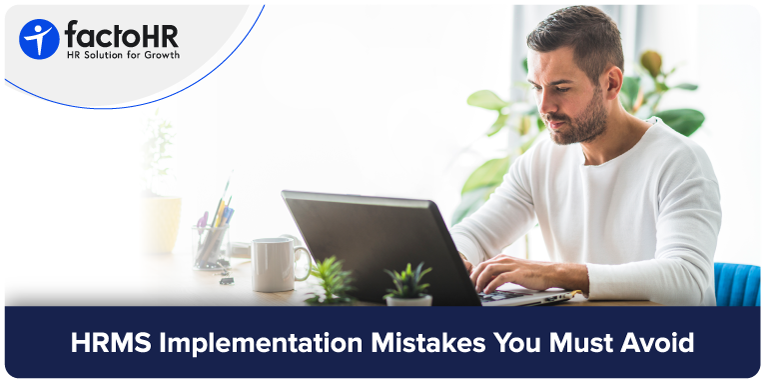5 HRMS Implementation Mistakes You Must Avoid

Table of Contents
Having HRMS software is a common practice, especially in the era of automation. However, adopting any HR solution won’t solve the perennial problems plaguing organizations. Successfully executing solutions to these problems is crucial for addressing challenges like data inaccuracy and compliance risks.
HRMS implementation mistakes, such as poor data migration and insufficient training, could pose issues related to operational efficiency and Return On Investment (ROI).
42% of organizations consider their HR implementation as failed or not successful. This reiterates the significance of properly implementing HRMS and underscores the need to address challenges in HRMS implementation.
This blog examines common reasons HRMS implementations fail and provides actionable solutions for negating these challenges.

What are the 5 HRMS Implementation Mistakes and How to Avoid Them?
Some common implementation challenges are poor data migration, overlocalizing an HR software, and neglecting change management. Data transfer challenges may be addressed by integrating with additional modules. Similarly, different mistakes can be addressed with tailored solutions. Here’s the list of 5 common HRMS implementation challenges-
- Lack of clear goals and requirements.
- Neglecting change management and employee involvement.
- Overlocalizing HR software.
- Insufficient training and education.
- Data migration planning and execution
Lack of Clear Goals and Requirements
Mistake: A lack of clear goals and requirements could result in several issues, such as underutilization, unnecessary customizations, and lower ROI gains. Your workforce, including HR, may struggle to maximize the use of the software without clear objectives. Also, executives might overcustomize the solution without knowing the specific requirements for having HR software. For example, if an organization is considering a solution for payroll management, it might not need other solutions like an ATS.
Solution: Defining objectives would be a good starting point. Clearly outlined goals will help a business choose the right HR software, as leaders will be aware of the current and future requirements. HR software vendors offer a variety of modules, such as self-service portals, payroll management solutions, and performance management software. Identifying your current and future needs will narrow the list of available options.
Neglecting Change Management and Employee Involvement
Mistake: Lack of employee involvement and haphazard change management would make HRMS implementation more difficult. Adopting HRMS software is a significant change, affecting the entire workforce. Most basic functions, such as applying for leave and viewing payroll-related information, would be performed with the help of HR software. Without HRMS, HR administrators might manually perform these functions.
Solution: Clear and transparent consultation with all stakeholders is essential when introducing new changes. According to the Global Workforce Hopes and Fears Survey 2024 | PwC, 44% of workers don’t understand the reasons behind changes.
HR software automates various manual processes and reduces time. However, it eliminates the need for some roles, such as HR analysts and designated payroll administrators. Leaders should consult employees and managers to better understand their needs and concerns. They should also clearly communicate all the potential impacts of adopting HRMS software, including recalibrating employees’ roles and responsibilities.
Overlocalizing HR Software
Mistake: Many businesses add too many customizations when configuring HR software to comply with local regulations. While it is necessary to adhere to regional regulations, overlocalization could lead to several maintenance-related issues.
Solution: Organizations should choose a flexible, scalable, modern core HR solution and implement a balanced approach. They should consult representatives from various regions before approving any changes in compliance-related customizations. They should prefer solutions that offer real-time updates regarding regional and global legislation changes to comply effectively with local and international employee laws.
Insufficient Training and Education
Mistake: Lack of sufficient training and education is one of the major HRMS implementation mistakes. It could create significant challenges, such as underutilization, resistance to change, and frequent delays in HR operations by employees and HR professionals. All these issues decrease a workforce’s operational efficiency.
Solution: Organizations should offer comprehensive training and development programs. Such initiatives would help address employee queries and upskill the current workforce if needed. Some solutions even offer AI-powered chatbots to educate employees and resolve their common queries.
They should also consider a vendor that offers comprehensive training and support for the selected software. This would ensure minimal delays in implementing the solution and assist the HR team in understanding some of the more technical aspects.
Poor Data-Migration Planning and Execution
Mistake: Inaccuracy, data inconsistency, and fragmentation are issues due to poor data migration.
- Data migration is a process in which data is prepared, selected, extracted, and transferred between different storage types.
- Data-fragmentation refers to scattered data across various systems, locations, and formats.
A lack of clear and cohesive data could delay the decision-making process.
Solution: Avoid excessive customizations and prefer integrated solutions. Two major reasons behind data fragmentation and inaccuracy are unnecessary customizations and a lack of integrated solutions. Only customize the components or reports that are necessary. Leaders and HR professionals need to be thorough with how HR software works to avoid similar issues. Also, prefer an integrated solution, as such solutions facilitate seamless and real-time access to data.

Conclusion
A few common HRMS implementation mistakes could arise when adopting HR management software. However, these challenges can be mitigated by defining goals, identifying current and future needs, and including all stakeholders while considering a solution. We prefer an integrated and scalable vendor who offers comprehensive support and training for successfully implementing the HR software.
An HRMS software like factoHR might be an ideal solution. Schedule a guided demo of factoHR to scale, integrate, and seamlessly implement HRMS in your organization with guided processes and comprehensive customer support!
Grow your business with factoHR today
Focus on the significant decision-making tasks, transfer all your common repetitive HR tasks to factoHR and see the things falling into their place.

© 2025 Copyright factoHR


